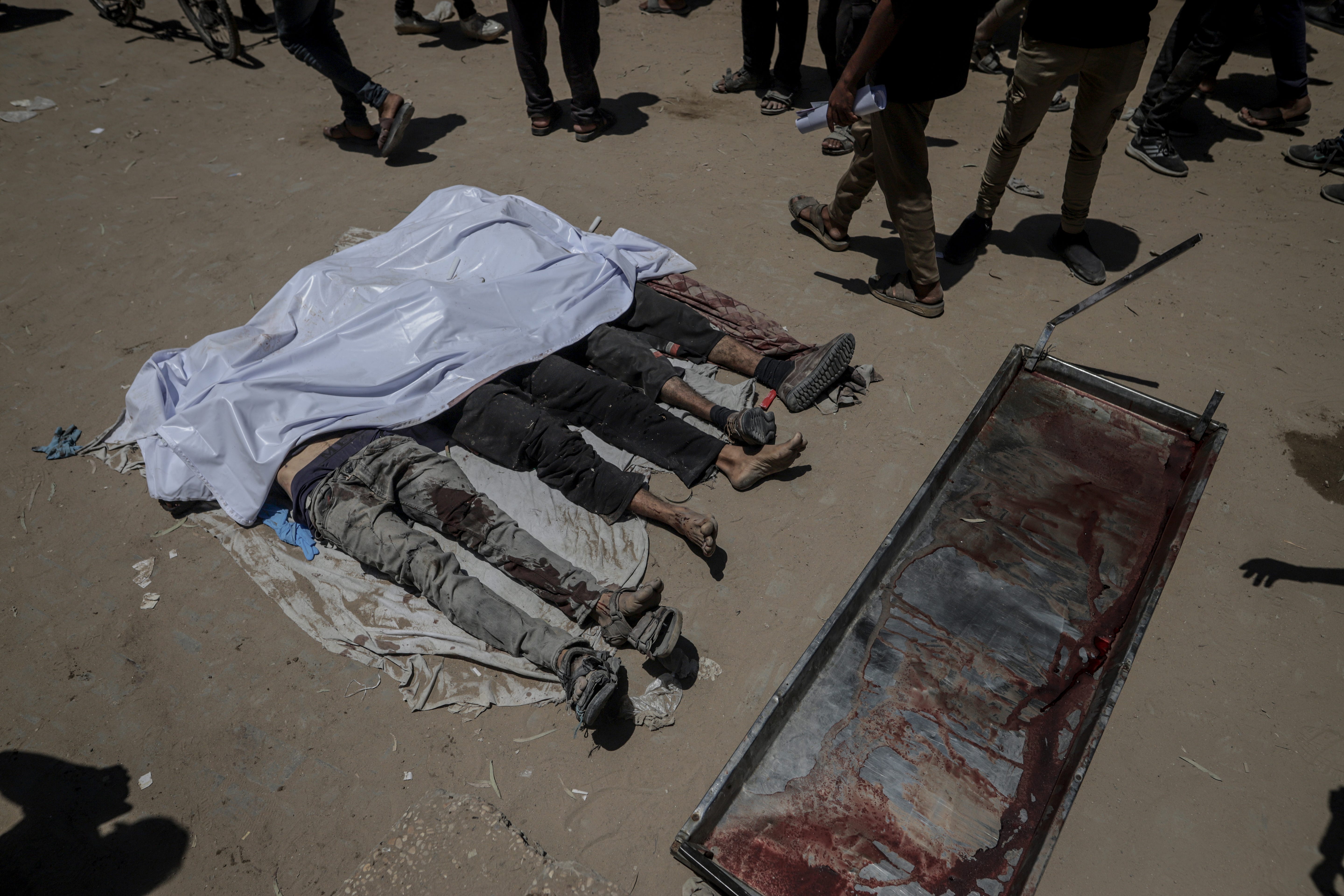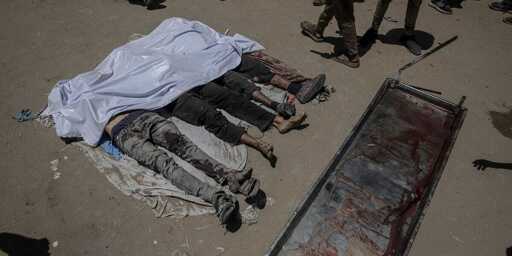 The bodies of Palestinians killed in an Israeli attack on the Zikim area in the northern Gaza Strip are seen lying on the ground at Al-Shifa Hospital in Gaza City, Gaza, on July 20, 2025. (Photo by Saeed M. M. T. Jaras/Anadolu via Getty Images)
The bodies of Palestinians killed in an Israeli attack on the Zikim area in the northern Gaza Strip are seen lying on the ground at Al-Shifa Hospital in Gaza City, Gaza, on July 20, 2025. (Photo by Saeed M. M. T. Jaras/Anadolu via Getty Images)
GAZA CITY—Israel’s war of extermination in Gaza continues to plunge to new depths of horror. Starving Palestinians have begun to collapse in the streets and die of hunger as a result of the siege. Those who try to get food are gunned down in ever deadlier aid massacres. The Israeli military issues frequent mass expulsion orders and further expands its ground operations, slicing up the enclave and forcibly displacing Palestinians into more concentrated zones. All the while, the relentless aerial assault and ground attacks persist.
Over the past five days alone, more than 550 Palestinians have been killed in Gaza, according to ministry of health figures. The confirmed death toll since the beginning of the war crossed 59,000 on Monday in what is widely acknowledged to be a vast undercount. Over the past two months, more than 1,000 Palestinians have been killed as they are forced to seek aid in militarized zones in a system mostly overseen by the Gaza Humanitarian Foundation (GHF), a shadowy U.S.- and Israeli-backed group.
One of the deadliest days for aid seekers came on Sunday, when over 70 people were killed, at least 67 of them in northern Gaza where Israeli troops opened fire on crowds trying to get food from a World Food Program convoy entering through the Zikim crossing.
“The tank came, surrounded us, and started shooting at us and we kept raising our hands,” Ibrahim Hamada, who was wounded in the leg, told Drop Site as he lay on a hospital gurney wincing in pain. “There were many martyrs, no one was able to retrieve them. I crawled on my stomach just to reach a car to take me to the hospital,” he said. “I went there to eat, because there was no food at home.”
Scenes from Shifa hospital after Israeli troops opened fire on Palestinians seeking aid near the Zikim crossing. Video by Abdel Qader Sabbah. July 20, 2025.
Over 150 people were wounded in the attack. Al-Shifa Hospital in Gaza City was overwhelmed with the dead and wounded, most of them young men and boys. Malnourished, gaunt faces poked out of white shrouds laid over their bodies on the ground. At the nearby Sheikh Radwan clinic, more than a dozen corpses in white body bags were lined up in the courtyard. Relatives searching for their loved ones came and gingerly pulled back part of the surface of the body bags to peer inside and see if they recognized anyone.
“The situation is very difficult. We transported the martyrs, as you can see, and moved the injured from a place close to the area that was targeted by quadcopter bombs, gunfire, or by the new [weaponized] crane located at the aid distribution site,” said Mohammed al-Hout, an emergency medical worker with the Red Crescent. “People were shot in the head or the feet.… Some of the martyrs have shattered skulls.”
Scenes from Sheikh Radwan clinic after Israeli troops opened fire on Palestinians seeking aid near the Zikim crossing. Video by Abdel Qader Sabbah. July 20, 2025.
The UN World Food Program said in a statement that 25 trucks carrying food entered Gaza on Sunday through the Zikim crossing “destined for starving communities in northern Gaza.”
“Shortly after passing the final checkpoint beyond the Zikim crossing point into Gaza, the convoy encountered large crowds of civilians anxiously waiting to access desperately needed food supplies,” the WFP said. “As the convoy approached, the surrounding crowd came under fire from Israeli tanks, snipers, and other gunfire.” The statement added: “These people were simply trying to access food to feed themselves and their families on the brink of starvation.”
Also on Sunday, nine Palestinians were killed near an “aid distribution” hub in Rafah run by the GHF. The killings happened at the same site where over 20 people had been killed a few days earlier when GHF guards gassed starving Palestinians fenced in at the hub, causing many to die from suffocation and a stampede.
These daily killings of Palestinians desperate for food and an imminent famine have combined to create an unprecedented emergency in Gaza. Israel’s full-spectrum blockade imposed on March 2 was nominally lifted on May 27 when meager amounts of aid began to be distributed to four militarized GHF hubs, three of which are located in the southern end of Gaza and one in Wadi Gaza. With the entire population on the brink of famine, Palestinians have no choice but to starve or risk their lives at so-called aid distribution hubs.
“People got hungry. They had no choice but to head towards the places of death. Either way, they’re going to die,” Abu Maher Al-Masry, who witnessed Sunday’s killings near the Zikim crossing, told Drop Site. “I am a grown man who can’t even walk from hunger. It has been more than a day since I last had a single bite to eat.”
On Sunday, the health ministry said that 18 people had died from starvation over the past day. A day earlier, the ministry issued an urgent bulletin saying “unprecedented numbers of starving people of all ages are arriving at emergency rooms in a state of extreme exhaustion and fatigue. We warn that hundreds of those whose bodies have emaciated will be at risk of certain death as a result of starvation and their bodies’ ability to withstand being overwhelmed.” Multiple reports have documented Palestinians sifting through garbage, scraping spilled food from the ground and eating from trash in the streets. The UN estimates that nearly one in three people is not eating for days.
Journalist Nahed Hajjaj posted on social media: “Do not be surprised when we journalists stop covering news here. I swear by God that today I could not get up from the hunger. There is no food. Even if someone has money, there is nothing in the market to even purchase.”
Meanwhile, Al Jazeera correspondent Anas al-Sharif broke down in tears during a live broadcast outside Al-Shifa Hospital as a woman nearby collapsed from hunger. “People are collapsing in the streets from hunger—just falling right there from extreme starvation,” he said. In response, an Israeli military spokesperson jeered at Al-Sharif on social media, saying it was “nothing but crocodile tears that comes as part of a deceptive and staged Hamas performance.”
A total of 86 Palestinians, including 76 children, have died of hunger and malnutrition since the war began in what the health ministry on Sunday called “a silent massacre.”
Drop Site News is reader-supported. Consider becoming a free or paid subscriber.
Philippe Lazzarini, the head of the United Nations Relief and Works Agency for Palestine Refugees (UNRWA)—that used to help oversee aid distribution in Gaza before Israel imposed its blockade and barred independent organizations—said on social media that the crisis was “all man-made, in total impunity.”
“Food is available only a few kilometers away,” Lazzarini posted on X on Sunday. “UNRWA alone has enough stock available outside of #Gaza for the entire population for the next 3 months. We have not been allowed to bring any aid in since 2 March.”
The widening starvation and famine comes as the Israeli military continues to expand its ground invasion, issuing repeated displacement orders, with more than 86% of Gaza now in a so-called “red zone”—either under active displacement orders or in a “combat” zone.
For the first time since the beginning of the war, the Israeli military on Saturday issued displacement orders in an area of Deir al-Balah in central Gaza, stretching to the coastline, along the so-called “Kissufim corridor.” Deir al-Balah is one of the few areas where Israeli ground troops have rarely operated and where the headquarters of several UN agencies and medical NGOs are based. The expulsion order effectively cuts access between Deir al-Balah and cities in the south of Khan Younis and Rafah. The Israeli military ordered people to head south to al-Mawasi, a tent camp on the southern coast that has been designated a “humanitarian zone,” which Israel has regularly bombed—most recently killing over 20 people, including children, sheltering in tents in an airstrike on Sunday.
Displacement orders were also reissued for northern Gaza, with the entire area north of al-Quds street and Salah Khalaf street designated an off limit “combat zone.”
Last week, the Israeli military announced it had finished bulldozing a 15-kilometer (9.3-mile) path through Khan Younis establishing what it called the “Magen Oz” corridor, cutting eastern Khan Younis off from the west side. The corridor is the latest of several zones that the Israeli military has carved through Gaza using wide-scale demolitions to divide the strip into separate regions: the Morag corridor, which adjoins Magen Oz and cuts Rafah off from Khan Younis; the Mefalsim corridor, which separates northern Gaza from Gaza City; and the Netzarim corridor, which runs along Wadi Gaza, cutting off the north from the south.
There are no signs that Israel’s assault will ease anytime soon and the international community has taken no steps to force Israel to end its attacks and to allow massive amounts of aid needed to stave off mass starvation.
“Damn this silence. Damn this famine,” said Eyad Amawi, a representative of the Gaza Relief Committee and a coordinator for local NGOs. “Damn it all—humanity has collapsed.”
Drop Site News Middle East Research Fellow Jawa Ahmad contributed to this report.
From Drop Site News via this RSS feed


